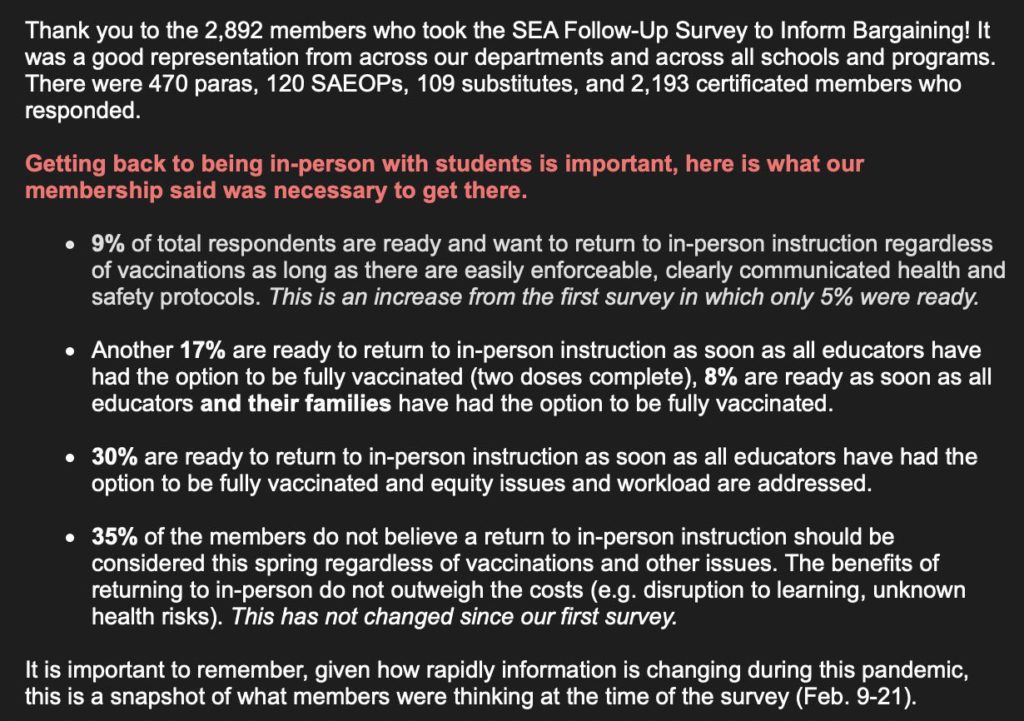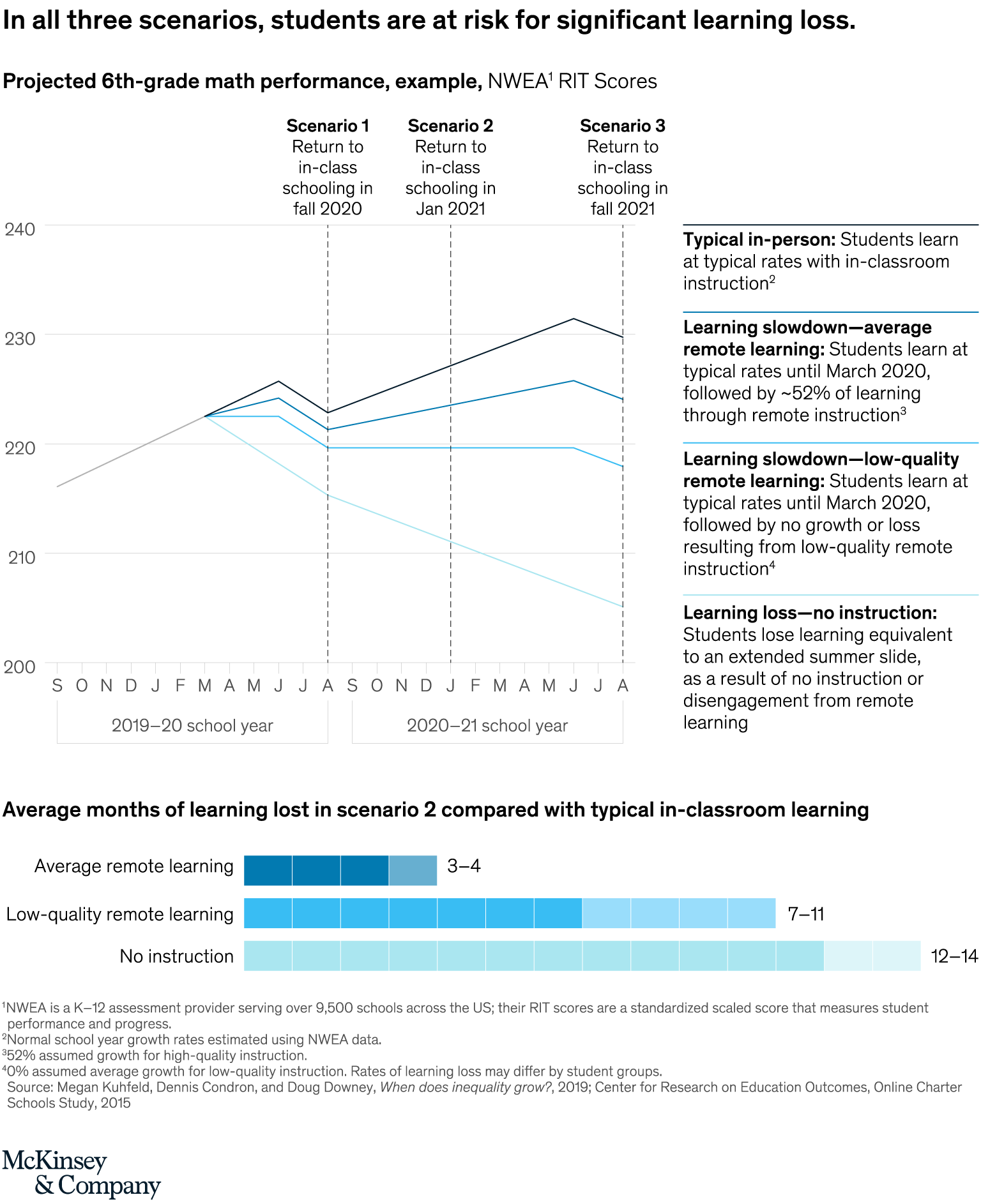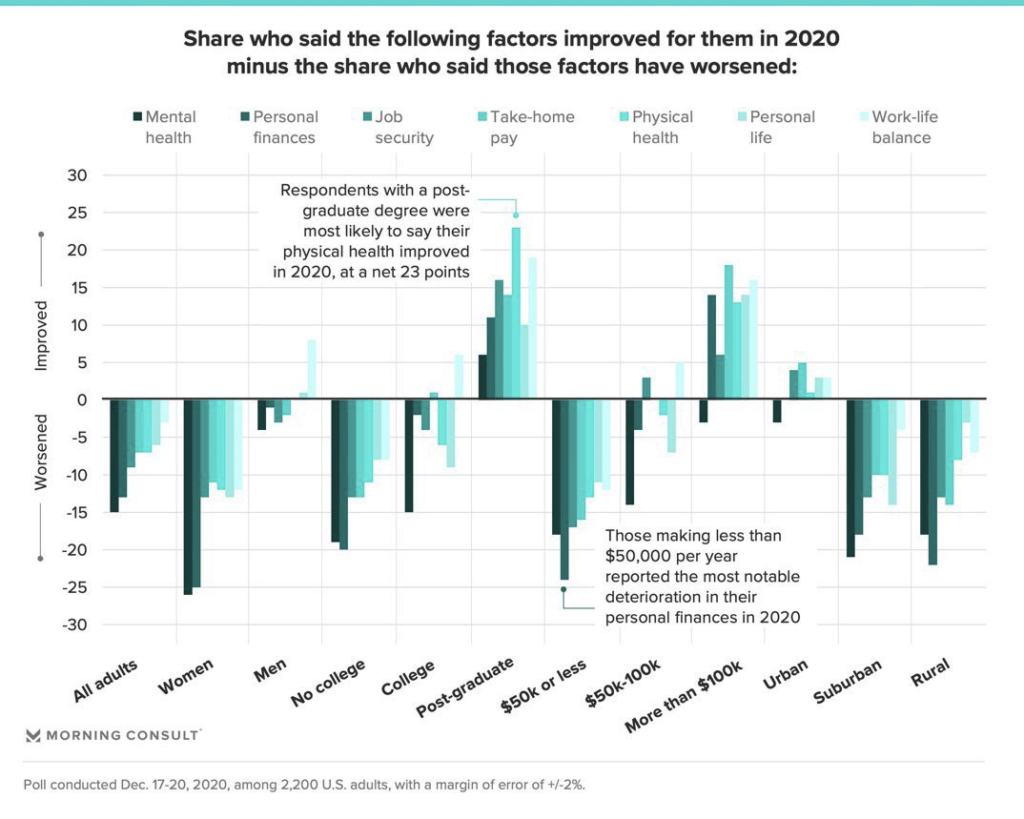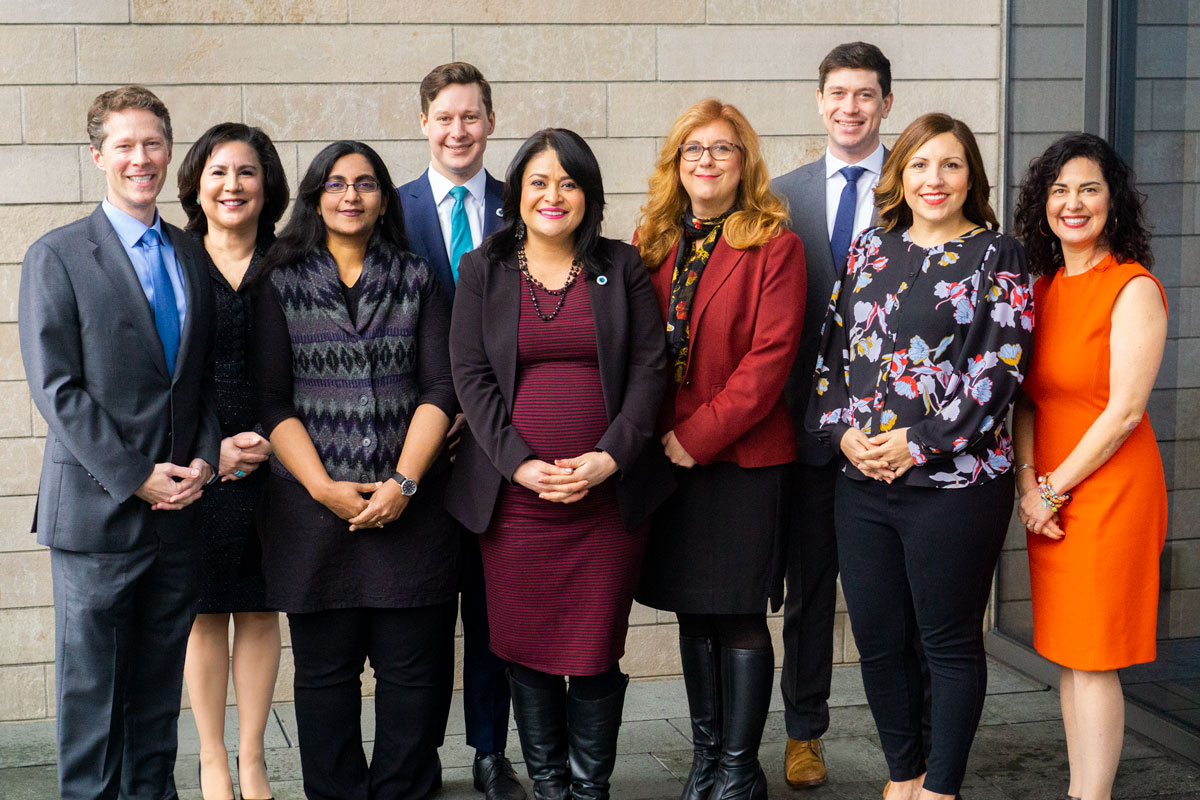What kind of leaders place endless, indefinite demands on kids 18 and under to “take one for the team” when all the available data shows that they shouldn’t have to?
A special anniversary is coming up, but it’s no cause for celebration. Seattle’s public schoolchildren have not set foot in a classroom since Wednesday, March 11, 2020. Seattle’s public school students are coming up on a full year without stepping into a real classroom with friends.
Even worse, for most Seattle students, rumors are growing that they may have to wait until the Fall of 2021 before they do so again. We were among the first large urban school districts to close, and we may well be the very last to open. There is no date set yet, as of this writing.
That’s March 2020, April 2020, May 2020, June 2020, September 2020, October 2020, November 2020, December 2020, January 2021, February 2021, March 2021 and maybe April 2021, May 2021 and June 2021… all spent remote. All spent outside a classroom. All with very little social interaction.
What the hell are we doing?
Do you remember first grade? Third grade? Seventh grade? Junior year?
Stop. Take a moment. Think back to those memories, and imagine if you spent an entire year, perhaps even a year and a half, entirely from your home, staring at a screen.
We must have more urgency. It’s time to put the kids first.
Yesterday, Seattle Public Schools announced that in-person learning for Kindergarten, First Grade and Special Education will be delayed yet again, opening at the earliest on March 8th. Negotiations with the unions representing Seattle’s teachers continue to drag on. As for older grades? Unclear — some are even suggesting it might be Fall of 2021 before that happens.
This is all so frustrating, and a tremendous failure of leadership, by union leaders and the school board. We cannot seem to get to “YES,” or even shared urgency of getting to YES.
Some might challenge this claim, and say that there’s tremendous urgency.
But how would leaders respond in an earthquake or massive winter storm?
If there were true urgency, why do these school staffing “leaders” throw in the towel on the previously signaled March 1st deadline on February 22nd? Why don’t union leaders specify concrete and reasonable must-haves, separating out things they’d like to have? Why aren’t all hands — including volunteers and parents — called to the deck to remedy, with clear instructions?
And what the hell were they doing from June of last year through now, when the pandemic was known, and safe reopening plans could have been codified and implemented?
Why are West Coast schools among the very last in the nation to reopen, the worst performing of all, even though we have lower rates of community spread and thus lower ambient risk than many areas which have safely reopened?
Why aren’t they even able to commit that if teachers are offered vaccination they will return a week after their second shot?
There are no clear conditionals, merely references to vague standards like “better ventilation,” without explicitly indicating where it falls short, and which metrics must be hit, and which studies back their demand that the health risk is unreasonable otherwise. The concrete sticking points in the negotiations aren’t being made transparent to parents and taxpayers.
It all feels like hide-the-ball.
In a survey of its members this month, the union representing Seattle teachers ended up with an astonishing 74% of teachers that felt it was not adequate even to be fully vaccinated to return. That’s unreasonable. That’s harming kids and families, and the disadvantaged the most.

Meanwhile, students from five years old to eighteen continue to wait, and fall further behind. Anxieties grow. Dropouts climb. Sports are delayed. In-person performances can’t happen. Social connections are delayed. Depression increases. Thoughts of suicide increase. Parents can’t go back to work. And more.
It’s Clear Where Relative Harm Lies
The learning loss is significant. McKinsey modeled this out in the fall, using the NWEA skill assessments. We are headed toward Scenario 3, in which major learning skills will be way behind for an entire generation of West Coast public schoolkids.

All this foot-dragging might be reasonable if the risks of reopening were clear and tremendous. It was entirely reasonable in September to imagine that they were.
But the data is in. In thousands of schools across the country, Europe and the rest of the world, leaders went ahead with autumn reopening plans — hybrid, in-person and even full reopening.
What’s clear from these real-world “experiments”: Reopening schools safely poses little risk.
We also know that keeping the school doors shut imposes enormous known harm.
We know these two facts. The evidence is right in front of us. It’s not just through modeling, but through real-world reopenings, all across the country.
Follow the science, or nah?
“Open the Schools” doesn’t mean we should cavalierly throw open all doors to all students 8am-3pm right away and jump back to November 2019 operating code. A phased reopening makes sense. De-densified return to campus, rotating grades makes sense. It can be done, and it is being done, all across the nation, across the world, and even in Seattle. It’s possible. But reopen. Open the schools.
Across the lake, Bellevue School District was able to reach a safe reopening agreement in January. The earliest learners in Bellevue have been going back to in-person public education for nearly a month now.
Why must we continue to impose the most harm on the least vulnerable? We need to follow the guidelines and follow the lead of other school districts which have done it, and safely reopen the schools. De-densify classrooms, follow the basic protocols.
We all know how to do this — we’ve been to grocery stores, retail stores, public transportation and more throughout this pandemic. They’ve all done it.
But don’t hold back a generation until absolute “perfection” is achieved, because this is about choosing the path of least harm — it’s about harm and risk reduction, not absolutism.
Teachers unions have said they are unsatisfied with the planning to date, because their staff is at risk, and they therefore implicitly say, staff safety must come first.
Well, let’s look first at vaccination. At this stage, Washington State has authorized all of those who are most vulnerable for health or age reasons to get a vaccine. They are able to do so. Those who are in this highest risk groups have been eligible to get vaccinated for several weeks now. There may be special cases where those over the age of 60 or so or those who have comorbidities have tried but have not been able to secure the vaccine, and for those teachers and staff members, it’s reasonable to have a carve out or delay. But that doesn’t appear to be the messaging from the teachers union — it’s kind of an all-or-nothing messaging for them.
It is well past time for Seattle Public Schools and the unions which represent Washington State teachers to find a way to YES. They need to immediately put a concrete plan in place to return kids to classrooms this year, as soon as possible. And it should be done by the end of February.
Sadly, at this writing, the communication is that Seattle Public Schools might not even open their doors this entire school year!
Here’s Seattle Public Schools Communication on this:
The data is in.
Back in September 2020, it was entirely reasonable to have concern that reopening schools might increase COVID spread, hospitalization and death.
Since that time, numerous districts across the country and the world have reopened. It is no longer reasonable to feel the risks of reopening exceed the harms of closure, because that flies in the face of numerous studies and real-world implementations. It’s science denialism.
In San Francisco, for instance, 114 private, parochial and charter schools have reopened to 15,831 students and some 2,400 staff. Those schools have had fewer than five cases of suspected in-person transmission, and zero mortalities. The mortality risks have been greater on the highway.
But this isn’t the only example. In The Truth About Kids, School and COVID-19, Derek Thompson of The Atlantic runs through numerous studies which have shown little to no risk to schoolchildren and staff. I encourage you to read it.
In an essay in the Journal of the American Medical Association, they wrote that the “preponderance of available evidence” from the fall semester had reassured the agency that with adequate masking, distancing, and ventilation, the benefits of opening schools outweigh the risks of keeping kids at home for months.
The Truth About Kids, School and COVID-19, The Atlantic, January 28, 2021
A month on from the publication of this piece highlighting just some of the evidence, it’s now February 22, 2021. Vaccines are available for nearly everyone who is most vulnerable — older populations, those with comorbidities.
- CDC: Strong Evidence In Person Schooling Can Be Done Safely, Seattle Times February 12, 2021
Numerous Studies Show The Risks of Safe Reopening Now Are Low
We’ve now run the A/B tests.
Many districts, charter schools and private schools have opened in the nation. Check out this chart, from early February 2021, which shows the percentage of schools with in-person learning. The color code of the row indicates whether it’s a “blue” or “red” state (by governorship.)
Do you see any correlation in this chart between a bias toward reopening and mortality rates? I don’t.
If harsh school lockdowns led clearly to statistically significant lower spread and therefore death, you’d see all the “high lockdown” states with much lower mortality. Yet it’s not really apparent from this chart. There are high lockdown states with high deathrates (e.g., NY, NJ) and high lockdown states with low deathrates (e.g., Hawaii, Washington.) There are low lockdown states with high deathrates (North Dakota) and low lockdown states with relatively low deathrates given their vulnerable (Utah, Florida, Alaska and more.)

You might reasonably counter that density is a key factor, but numerous studies of actual school reopenings, in both dense and sparse areas, show that schools do not seem to be a major vector of worrisome community spread. At the very least, the risk of spread pales in comparison to the certain harms imposed by keeping them shuttered.
The State of Delaware has had nearly all its private and parochial schools open throughout the pandemic, including through the peak of the second wave. Have you been reading any stories about major outbreaks caused by Delaware schools, leading to excess hospitalization or mortality? No? What does that tell you?
Keeping the School Doors Closed Is Hurting Kids and Society
Lockdowns are imposing massive achievement, socioeconomic and emotional well-being gaps on a generation of kids. Seattle’s leaders don’t seem to have the sense of urgency around this issue; they begin plans too late and are too quick to say “Nope, can’t.”
Down south of us, the City of San Francisco got fed up and recently sued its own schools, citing record suicide data:
UCSF Benioff Children’s Hospital has seen a 66% increase in the number of suicidal children in the emergency room, and a 75% increase in youth who required hospitalization for mental health services, the lawsuit said, quoting pediatricians, child psychiatrists and emergency room doctors.
Last month, UCSF Children’s Emergency Department at Mission Bay reported record high numbers of suicidal children seen and treated, according to the legal filing which did not provide detailed numbers of cases and hospital visits. It also quoted doctors citing an increase in anxiety, depression and eating disorders among children, consistent with national data.
“The medical evidence is clear that keeping public schools closed is catalyzing a mental health crisis among school-aged children in San Francisco,” Dr. Jeanne Noble, director of COVID Response for the UCSF Emergency Department.
San Francisco sues schools, cites high of suicidal students – ABC News (go.com)
Perhaps these anxieties and setbacks will be short term, as Randi Weingarten hopes:
But what if Weingarten is wrong? What if these gaps last for years? What if it sets the stage for their lives? We don’t yet know. But we do know that learning gaps are widening today.
“Learning loss and higher dropout rates are not likely to be temporary shocks easily erased in the next academic year.” — McKinsey & Co.


Why can’t we make this work? Why can we make grocery stores, Best Buys, Home Depots, many retail stores, and even now some restaurants work and not schools? Why aren’t the Washington Education Association (the powerful teachers union) and Seattle Public School board working overtime trying to figure it out? HUGE disparities between states in reopening, yet very little evidence that it leads to increased hospitalization and mortality. What message does that send to students and families about the value of determination and in-person public education?
There are huge disparities we are imposing on kids: blue vs. red state students, public vs. private students, wealthy vs. non-wealthy students, and far more. By not working harder to open schools, we are dramatically expanding these disparities. Incredible that this same institution wants to lecture us about wanting to close those disparities when they are in the middle of dramatically expanding them.
Lockdowns are Hurting Families
Parents are burning out. They are unable to go to work. Public schools was a social contract that we taxpayers pay for that yes — includes on-site supervision as well as instruction.
What Makes West Coast Teachers Uniquely Vulnerable?
Perhaps someone can tell me what makes West Coast teachers uniquely vulnerable.
Throughout the pandemic, cashiers have gone to work. Grocery store re-stockers have gone to work. Plumbers have gone to work. Doctors and nurses and firefighters have gone to work. Airline employees have gone to work. Line cooks have gone to work. Yet teachers cannot?
So many teachers want to get back to work, but their unions and in some cases school boards are conspiring to keep the fear dialed to eleven. The goalposts constantly move. Union reps are sent to social media to click the “laugh” emoji when parents express reasonable desire to see concrete plans for reopening. Why can’t some unions even say that after offering the teachers they represent the vaccine that then they’d be willing to reopen schools?
It Sends the Wrong Message to Kids
Do you think students don’t notice that we as a society have been able to keep Best Buy open? Target open? Office Depot open? Grocery stores open? Restaurants and bars de-densified but open?
What does that say about our priorities? What will that say to them about the importance of resilience and courage in the face of risk? The assessment of greater harm?
COVID Absolutism Is Bonkers
There are risks with reopening, but there are known and huge risks with keeping schools closed. They include, but are not limited to:
- Learning Loss
- Mental Health
- Suicide
- Failures to Launch
- Lack of Social Connection
- Sports
- Holding Back Parents and Families
… and more.
People under 18 are less susceptible to infection, less likely to experience severe symptoms, and far less likely to be hospitalized or die.
Yes, there are risks for teachers and staff. But vaccinations are here for those who fall into the most vulnerable brackets, and very much on their way for those who do not. Yet at this writing, Seattle Public Schools and the Unions have not even reached an agreement stating that even after being offered vaccination (nor even a second dose) will they will return.
It all feels like a game of hide-the-ball at this point.
My only hope is that voters will remember.

